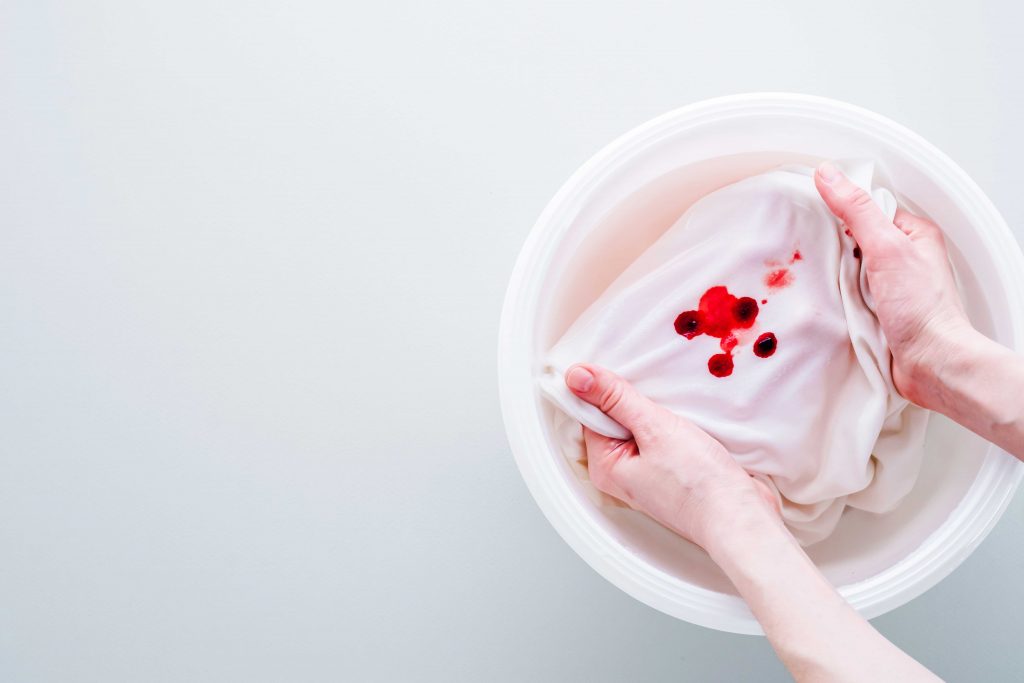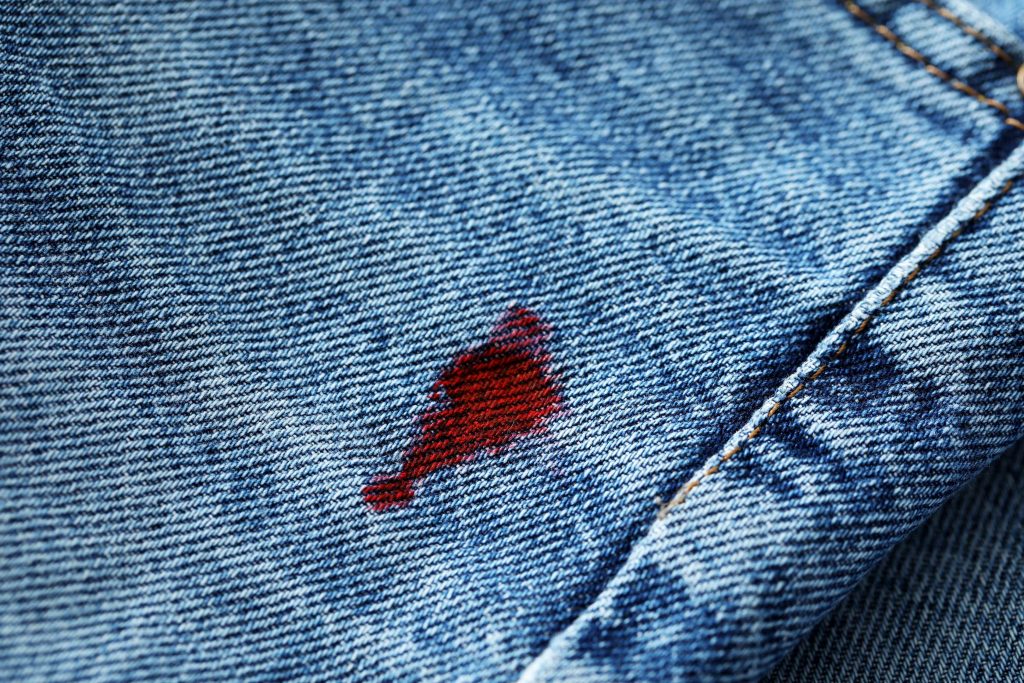 Get How-To's
Get How-To's
Laundry Symbols: Your Guide to Garment Care
Discover price transparency and savings in our Calculator!
Read tips, tricks, and how-to’s on our Fabric of Life blog.
How-To's

When you need to get blood out of clothes, time is of the essence. The quicker you act, the easier it will be to remove the stain. The best thing to do is take your garment to a dry cleaner as fast as possible, but if you want to work on getting the blood out yourself, this article will serve as a guide.
Blood contains proteins that can bind to the fibers of your clothes, and as the blood dries, it becomes more challenging to remove. Acting swiftly can prevent the stain from setting in and becoming a permanent mark on your garment.
Blot the Stain: If the blood stain is still wet, gently blot it with a clean, dry cloth or a paper towel. Avoid rubbing the stain, as this can cause it to spread or penetrate deeper into the fabric fibers.
Rinse with Cold Water: Hold the stained area under cold running water. The cold water helps to loosen the blood particles from the fabric. It’s important to use cold water because warm or hot water can cause the blood to coagulate, making the stain harder to remove.
Check Fabric Care Labels: Before proceeding with any stain removal techniques, always check the garment’s care label. Some fabrics may require special care, and using the wrong method can damage the fabric. This can be confusing, so refer to our guide on how to read laundry symbols.
Pre-Treat the Stain: If the stain remains after rinsing, you can pre-treat it with liquid laundry detergent or a stain remover. Apply a small amount to the stain and gently rub it with your fingers or a soft-bristled brush. Let it sit for a few minutes, but don’t let it dry.
Blot Again: After pre-treating, blot the area with a dry cloth. This will help lift more of the blood particles from the fabric.
Following these steps promptly increases the likelihood of completely removing the blood stain. Remember, the key is to act quickly and carefully handle the stain to avoid further damage to your clothing.

Direct Water flow: Place the stained clothing with blood on shirt item under cold running water from a faucet, which helps dislodge and flush blood particles from fabric fibers. Be sure that water passes over and around rather than through the stain to push out blood particles from fabric fibers without spreading their stain further.
Gently Agitate: While submerging fabric in cold water, lightly rub the stained area using your fingers – light agitation will help loosen blood from fabric fibers and dislodge bloodstains from fabric threads. However, be careful not to scrub too aggressively or damage its fabric, as doing so might embed the stain more deeply.
Soaking Option: For stubborn blood on a shirt stains, submerging clothing in cold water for 30 to 48 hours may help loosen bloodstains. You can gently stir this water every so often for best results and gently agitate to loosen any blood clots from within it. Soak time can vary according to the severity of the stain.
Change Your Water: If the blood becomes visible during soaking, drain and refill with fresh, cold water to expose stains to clean water to get blood out of a shirt more effectively. This will ensure the stain remains exposed for removal over time.
Repeat as Necessary: If the stain remains after an initial rinse or soak, repeat this process as multiple cold-water rinses or soaks may be required to eliminate blood staining. Sometimes, repeated attempts at removal require multiple rounds.
By employing cold water and these effective rinsing techniques, your chances of successfully eliminating bloodstains from clothes will drastically improve. Patience and gentle handling are paramount for protecting fabric quality while treating stains.

After an initial cold water rinse, the next step should be selecting an effective stain remover to combat any remaining blood stains. Numerous cleaning agents are suited for different fabrics and stain severity levels; we will discuss some popular ones, such as hydrogen peroxide and soap, to help you choose one effectively.
Hydrogen Peroxide: Hydrogen peroxide is an ideal mild bleach solution against blood stains on light-colored and white fabrics, particularly since its molecules help break down blood’s structure to simplify removal. Knowing how to get blood out of white is crucial. Simply apply a small amount directly on top of any stain before waiting a few minutes while it fizzles, and then thoroughly rinse it off with cold water afterward. However, hydrogen peroxide could stain colored fabrics, so be wary when applying, especially as overexposure may discolor them – always do a spot test first to determine the best results!
Liquid Laundry Detergent or Dish Soap: These options provide gentle yet effective cleaners for most fabric types, particularly delicate or colored clothing items with stain marks or spots that need treatment. When applied directly onto stained areas, simply rub in small amounts of detergent/dish soap using circular movements before leaving to sit for several minutes and rinse afterward. These cleaners work especially well when dealing with stubborn stains that require time-intensive treatment methods like paint, ink pens, or paint rollers.
Enzyme-Based Stain Removers: These products are engineered to break down proteins found in blood stains, making them suitable for removal from fabric types that typically are safe against them (i.e., cotton). Apply the cleaner directly onto stains (typically 5-10 minutes before rinsing off), then let it sit as directed (usually 5-10 minutes).
Finding an Appropriate Cleaning Agent: Selecting an effective cleaner depends heavily on two variables: fabric type and stain severity. When cleaning delicate fabrics, gentle options like soap or laundry detergent might do the trick. However, for tougher or set-in stains on durable materials, hydrogen peroxide or enzyme cleaner may prove more efficient – always consult care instructions first, however! Always carry out spot tests regardless of which cleaner you select!
Keep in mind, however, that effectiveness will depend on factors like stain age, fabric type, and the color of the garment being stained. Removal may require multiple methods or attempts before finally completely clearing away the stain – patience will go a long way toward maintaining the quality and appearance of clothing!
Gentle scrubbing is essential when treating blood stains on fabrics. Relentlessly scrubbing can damage fibers and spread the stain further, so here’s how you can effectively scrub without harm:
Employ a Soft-Bristled Brush or Cloth: For gentle fabric cleaning, using a soft-bristled brush or a clean cloth is optimal. Both options will ensure that no damage occurs while cleaning is taking place.
Apply Light Pressure: Gently rub the stained area in a circular motion to use a cleaning agent on its target area without being harsh on fabric fibers. This should work toward extracting all possible stains without straining fabric fibers further.
Rinse and Refresh: After giving the area a gentle scrub, rinse it out using cold water to rinse away any remnants of the cleaning agent applied earlier in this process. If any remaining stains persist, add more cleaning agents and repeat.
Soaking can be an effective solution to remove stubborn stains, particularly ones that have dried and set.
Fill a Basin With Cold Water: Add enough cold water to submerge the garment in its entirety completely.
Add Stain Remover or Mild Detergent: In small doses, add laundry detergent, stain removers, or stain removal solutions for best results.
Soak Time: Allow the garment to soak for at least 30 minutes up to several hours, depending on the severity of the stain.
Agitate Occasionally: Agitate the water occasionally to help loosen any stubborn stains that might otherwise remain. This should speed up the removal process significantly.
After treating and rinsing away any spots on your clothing, machine wash it immediately for optimal results.
Choose an Appropriate Cycle: Select an appropriate cycle based on fabric type and your sewing experience.
Cold Water Wash: When cleaning with cold water, beware that any stain may set. Use caution not to set it!
Mild Detergent: Choose a detergent designed specifically to clean fabric types for best results.
Before placing the garment into the dryer, remove all stains.
Examine the Stain Areas: Repeating treatment will likely be necessary if any part of a stain remains.
Avoid Heat Drying: Overdoing it with heat drying could leave behind permanent stains; only dry the garment once the stain is gone before doing it again.
Sometimes, repeated treatments are necessary to eliminate stubborn stains.
Professional Cleaning: If the stain persists, take your garment to a professional cleaner for care and cleaning.
Effective blood stain removal requires quick action, the appropriate cleaning products, and gentle handling. By following these steps, you can successfully treat blood stains on clothing while keeping their appearance at their best.
Test on a Small Area: Always perform a preliminary test on an unseen area of clothing to ensure cleaning solutions will not discolor or cause other types of damage, and take extra caution with delicate fabrics or costly or sentimental pieces that could require professional advice for effective stain removal. Patience and careful treatment are the keys to effectively eliminating blood stains!